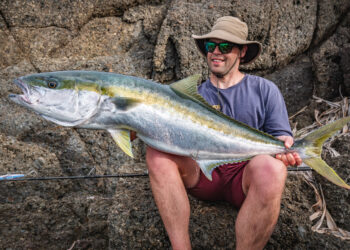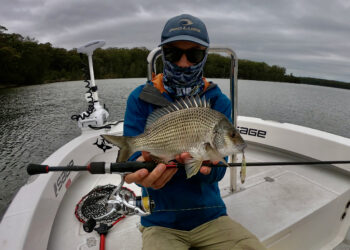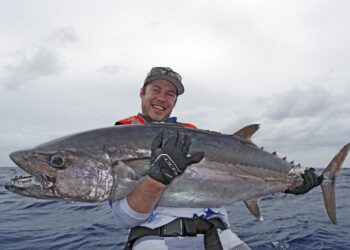
FISHING World readers will be well aware of the great surf fishing to be had along the coasts of NSW and Queensland. The phenomenal beach fishing for bread-and-butter species like tailor, sand whiting, bream and dart in the warmer northern states is compelling and well documented. What isn’t so well publicised, however, is that there is also some very good surf fishing to be had from beaches further to the south, and particularly in Victoria. It’s different, but it’s good different.
THE MAIN GAME
In Victoria, the most commonly targeted species in the surf would have to be the Australian salmon. When it comes to sportfish, “sambos” just about have it all. They are frantic fighters that pull hard and often jump when hooked, they grow to a good size, and they are voracious consumers of both bait and lures. They are a schooling species, too, so once you’ve found one you’re likely to find a lot. What’s more they are widespread and can be targeted at any time of year. In fact, winter can be the most productive time to chase salmon in the deep south, which makes them popular in the colder months when little else is biting.
You’ll notice, though, that I said Aussie salmon “just about” have it all. Their one big downfall, in my opinion, is that they are average on the plate…which I guess makes them the perfect catch and release species. They are not inedible by any means, it’s just that they are a long way down most people’s list of favourite table fish. There are those who will argue that smaller specimens bled and kept on ice are more than acceptable fare when eaten fresh and I would agree with that. I have also had some extremely tasty smoked Australian salmon. For the most part though, the bigger specimens are best returned to the water to fight another day.

WHERE?
Australian salmon are most definitely a southern species, with an extensive range stretching from Newcastle, NSW, all the way around the southern coast into Western Australia at least until north of Perth. They are also found in Tasmania and across the Ditch in New Zealand where they are known as “kahawai”.
I’m sure anglers from South Oz and WA will quickly point out that their salmon, which are actually a separate species, are typically much more impressive than those encountered in Victoria. With fish commonly averaging 4 or 5 kg and occasionally reaching 8 kg or more, I have to grudgingly concede that the Western Australian version is superior in that regard. Nevertheless, the eastern version of the species is abundant in Victorian waters where they range in size from a couple of hundred grams to 3 or 4 kg. They can be caught at virtually any surf beach, as well as in countless bays and inlets. Noted surf fishing hotspots in the Garden State include Apollo Bay in the west, beaches closer to Melbourne such as Gunnamatta and Kilcunda, Williamsons Beach south of Venus Bay, the South Gippsland beaches of Ninety Mile Beach, Woodside Beach, Seaspray and Golden Beach, and the more remote beaches of East Gippsland off Bemm River and Mallacoota.
No matter which beach you choose, it will pay to spend a few minutes observing the water from the top of the dunes, before rushing down to fish. Sometimes the salmon themselves can be seen, often showing as the dark shadow of a mass of schooled fish potentially acres in size, but usually much less, and sometimes accompanied by birds diving to feed on the baitfish pushed to the surface by the salmon. Sometimes the signs are much more subtle, such as an area of shimmer on the surface. If they are really close, individual fish can sometimes be seen in the waves. If you can see fish, get down and cast to them, pronto!
If you can’t actually see the fish, you’ll need to find an area of deeper water running parallel to the shore, called a “gutter”, within casting distance. Preferably, such a gutter will be connected to the open ocean via a channel at least one end, allowing the salmon easy access. Anywhere along this deeper gutter should prove productive if there are salmon around.
Be aware that you don’t always need to cast as far as you can. In fact, casting too far can land your bait up on top of the sand bank on the far side of the gutter, while in the meantime salmon and other species are foraging along the shore break. I have experienced some frustrating sessions during which I have been out-fished by my father using his museum-grade equipment to cast just beyond the wash while I was putting in hero casts with my much more expensive gear. So, experiment until you find the best range. As far as tides are concerned, any time is worth a try but I prefer to fish a high tide on the change of light at dawn or dusk.
BAIT IS GREAT
If I was a betting man, I’d wager that the vast majority of Australian salmon captured from Victorian beaches succumbed to bait of some kind. Of those baits I would say that fish baits such as bluebait, whitebait or cut pilchard would be the downfall of most. These types of baits are best presented on a paternoster rig with two droppers hosting a strong long-shanked hook such as a Gamakatsu O’Shaughnessy or Mustad Baitholder in size 2/0 to 4/0, and a heavy star sinker at the end. Other good baits for salmon include pipis and squid (squid is a much tougher bait than pipi). It’s best to present baits as naturally as possible, rather than all scrunched up on the hook. Sometimes elastic can be used to keep bait on the hook for longer if the crabs are bad. Alternatively, whole pilchards can be presented on a set of ganged hooks beneath a large running ball sinker, much as you would do for tailor in the north.
A great tip is to attach a feathered surf popper to one of the droppers and a baited hook on the other, rather than having two baits. That way you’re sure to always have at least one active offering in the water even when there are crabs around.

A SLICE IS NICE
Another highly effective way to tempt salmon in the surf is to cast and retrieve metal slices. Choose one weighing between 10 and 50 g depending on what gear you’re using. These heavy, silver lures glint and flash in the water to represent bairfish, and salmon often attack them aggressively. They are simple to use too: just cast them as far as you can and wind them back in as fast as you can. No finesse needed! I like to take at least one lure casting outfit with me on every outing to the surf so that I can cast a few slices around while waiting for a bite on the bait rod. Last year though, fishing on a beach in East Gippsland with two of my sons and one of their mates, metal slices out-fished bait by at least seven or eight fish to one…so be prepared to be flexible so far as your technique is concerned.
If you are using slices, you will often have better success at hooking and landing salmon if you replace the galvanised treble hooks that they are typically supplied with, with a strong, sharp single hook. Single hooks just seem to get a better grip.

GEAR
Along Victorian beaches, threadline reels rule the roost. You’ll be lucky to find even a single sidecast reel in these parts, despite their overwhelming popularity in the north. Although some southern surf anglers still insist on spooling their eggbeaters with monofilament line, I have made the switch to braided lines for all the obvious reasons. It gives you far greater strength for a given diameter, which means that you can cast much further if you need to. Best of all its reduced stretch means that bite detection is much easier than with monofilament, although that same feature means that it is slightly less forgiving in the final stages of the fight when the retreating wash can put extra pressure on the fish.
So far as rods are concerned, traditional surf poles of 9 to 12 feet in length give you greater authority when bait fishing in the thunderous Victorian surf. If casting metal slices you will get away with lighter spin outfits if you downsize the weight of the lure. Many a lure has been sent into orbit by casting a heavy lure on line that just cannot handle the strain.
OTHER SPECIES
Besides salmon, other species that you are likely to encounter along Victorian surf beaches include tailor, which occur mostly in the eastern extremes of the state. Tailor commonly take the same baits and lures as you would use for salmon, but they are unlikely to reach the gargantuan proportions of those you might encounter in Western Australia or Queensland. Flathead and snapper are also a popular target for southern surf anglers, particularly along the beaches of South Gippsland…and there are some mighty big specimens of both species landed every year. All along the coast, gummy sharks are fished for by dedicated anglers fishing mostly at night with a bait of cured eel or squid pinned offered on a single hook anchored by a large running ball sinker. Other odds and ends captured at times include yellowfin bream, silver trevally, mulloway and elephant fish.
So, what are you waiting for? The beaches of Victoria provide ample opportunity to mix it with a hard-fighting adversary in some very scenic locations and often at a time of the year when there is little else on offer. What’s not to like?
DID YOU KNOW?
- So far as Australian salmon are concerned, the name “salmon” is a misnomer. These fish are not true salmonids (family Salmonidae). Instead they are members of the family Arripidae, a group of fish occurring only in Australian and New Zealand waters.
- There are actually three species of Australian salmon in Australian waters. Western Australian salmon (Arripis truttaceus) breed in the southern parts of WA, and their eggs and juveniles are dispersed into South Australia, Victoria and Tasmania.
- This species grows to around 80 cm fork length, but adult fish are rare in Victoria as they tend to migrate west towards the spawning grounds as they grow.
- The Eastern Australian salmon (Arripis trutta) occurs mostly in New South Wales, Victoria, Tasmania and New Zealand. This species usually doesn’t grow as large as the western species.
- The biggest Aussie salmon of them all is the northern or large-tailed kahawai (Arripis xylabion). This species can reach 1 m long and over 10 kg in weight, but is found mostly around Lord Howe and Norfolk Islands.
For further information on Australian salmon, check out this informative article by Dr Ben Diggles.
















